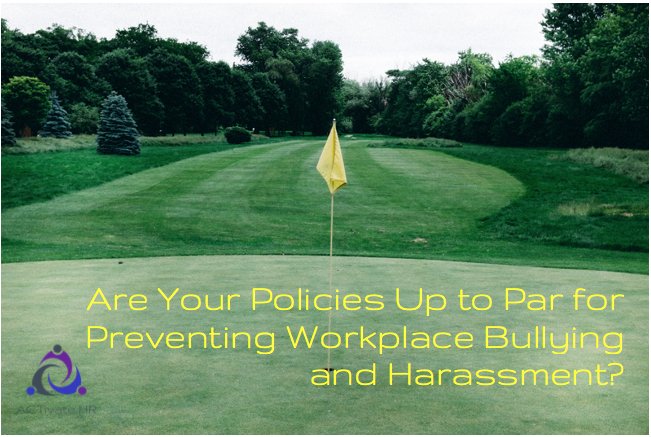Are your HR policies and procedures up to par for preventing workplace bullying and harassment? Taking the time now to make sure they are will save you a lot of trouble down the road.
As we learned in our blog on getting ready for Bill 30, the first step to creating a psychologically safe and healthy workplace is making sure your HR policies and procedures are up to date. Now, in this blog in our series on complying with the June 1, 2018 updates to Alberta’s occupational health and safety legislation, we go even deeper.
Today, we’ll discuss what to consider when implementing or reviewing your HR policies and procedures on workplace bullying, harassment, and others that relate to psychological safety.
If you don’t currently have a policy for the prevention of bullying and harassment in the workplace, now’s the time to put one in place. If you already have a policy addressing bullying and harassment, review it to make sure it aligns with current legislation.
How to make sure your HR policies and procedures are up to par
Not sure what to include or where to start? Here are some key items to consider:
1. Make sure you consider all HR policies and procedures that may need new definitions and revisions.
Content about harassment and bullying is often included in many policies such as a Respectful Workplace Policy, Code of Conduct or Company Ethics Policies, and Workplace Discrimination and Violence Policies.
- Harassment and bullying are found even in Human Resources departments. With the new legislation, make sure your safety policies are also updated to include harassment and bullying as a safety hazard.
- You may want to have a separate policy addressing harassment, sexual harassment, bullying, and other forms of psychosocial harm such as discrimination. You can also use this as a reference in other human resources, safety, and corporate policies.
Speaking of HR here’s more on what it’s got to do with your bottom line.
2. Check for clear statements.
Make sure your policy includes a clear statement of management’s commitment to health and safety including psychological safety.
3. Include terms that are new to the legislation.
Here are some examples: psychologically safe workplace, psychological harm, and supervisor.
4. Update your harassment definition.
The new definition of harassment is more expansive than traditional definitions. Many companies need to expand their definition in their HR policies and procedures:
- “Harassment” means any single incident or repeated incidents of objectionable or unwelcome conduct, comment, bullying, or action by a person that the person knows or ought reasonably to know will or would cause offense or humiliation to a worker, or adversely affects the worker’s health and safety.
- Your definition should also include what harassment is not: any reasonable conduct of an employer or supervisor with respect to the management of workers or a work site.
- Companies should have a good internal definition and understanding of what reasonable conduct includes. Then, questions and complaints can be addressed quickly as they arise.
5. Include responsibilities for employers, supervisors, and workers.
These are laid out in the new legislation and can also be found on the Government’s website in the guides that they provide on changes to the legislation.
6. Include processes employees should follow if they witness, or are subject to, bullying or harassment in any form.
Ensure you include a reporting process with clearly defined accountabilities and timelines that are easy to access by all employees.
- Reporting processes need references in both human resources and safety processes.
- Be careful not to simply add bullying and harassment to current safety reporting processes. There’s a sensitive nature to psychological safety. Consider a confidential reporting process that goes through the human resources or compliance department.
- What if the employee’s leader, company senior leadership, or human resources is part of the harassing or bullying behaviour? Have specific processes for these situations.
7. Consider other areas of psychological safety
The new legislation also speaks to other areas of psychological safety beyond bullying and harassment. For example, protecting against domestic abuse by assisting employees in preventing abusive spouses from entering the workplace. Review the legislation to determine all requirements as they relate to providing a psychologically safe workplace. Be sure to include your processes in all areas.
Clear and comprehensive policies are a critical first step in providing a psychologically safe and healthy workplace. These policies don’t need to be long or complex. In fact, the best policies are simple and written in common language.
Following these tips helps you create clear and effective policies to prevent or address, bullying, harassment, and other forms of psychological harm in the workplace.
This article is the second in an 8 part series to help you get ready for Bill 30 implementation. It’s an important part of moving your company forward in creating a psychologically safe and healthy workplace. To see the previous article in the series click here. Or the next in the series can be read here.
Help with updating your HR policies and procedures
Contact us at info@activatehr.ca if you have any questions about this or any other article in this series. If you’d like help creating or updating your workplace policies, reach out today!
Interested in learning more about our services? Click here.
Follow us on LinkedIn to stay current on our news and articles.
Enjoyed this article? Here are three more to help you:
Acting ‘Reasonably’ in Your Workplace: 5 tips to help you avoid harassment claims
Effective Communication Techniques to Bring Your Workplace Harassment Policy to Life
Effectively Investigating Workplace Bullying and Harassment Hazards and Incidents
This article was originally published in 2018, but has been updated in 2020 just for you!

